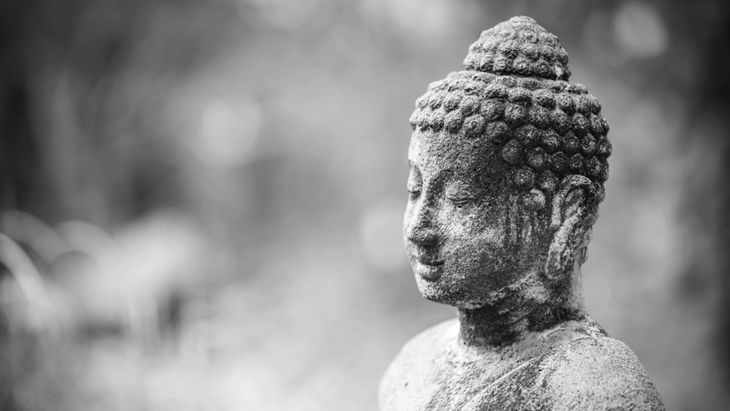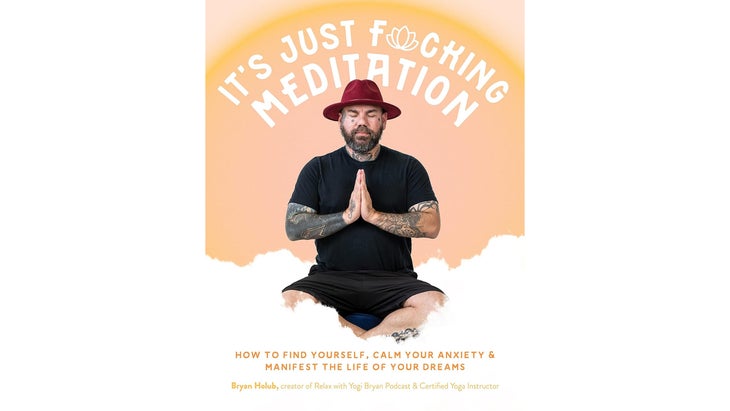“], “filter”: { “nextExceptions”: “img, blockquote, div”, “nextContainsExceptions”: “img, blockquote, a.btn, a.o-button”} }”>
Heading out the door? Read this article on the new Outside+ app available now on iOS devices for members!
>”,”name”:”in-content-cta”,”type”:”link”}}”>Download the app.
Meditation is a curious thing. It’s essentially the same practice, no matter who engages in it, yet it can challenge us in ways that feel self-defeatingly unique. Helping us overcome those challenges is what drew meditation teacher, comedian, and everyday kind soul Yogi Bryan nearly one million followers on Instagram as well as a dedicated following for his podcast, his sleep app, his YouTube channel, and his just-released book, It’s Just F*cking Meditation. He not only makes sitting still simple and non-woo-woo, but he has a way of understanding and overturning all of the excuses we tell ourselves when it comes to the practice of meditation. What results is the universal yet unique experience of slowing our thoughts and profoundly shifting our perception of ourselves, our situation, and, by extension, our life. His approach helped my 77-year-old mom slow her breath, quiet her thoughts, and sidestep her anxiety. He can also help you. —Renee Schettler, Executive Editor
We’d all like to be the kind of people who can meditate each and every day, but let’s face it: Life has a way of getting in the way of our best-laid plans. We’re pressed for time, under a lot of stress, and completely worn out.
Finding the time to sit still and reflect through meditation can be difficult, particularly when you’re overworked and exhausted. Also, the process of emptying your mind during meditation is one of the more difficult aspects of the practice.
But have no fear, those of you who put off practicing meditation! Following are some suggestions on how to find time to meditate, even when it appears that there are only 10 seconds left in the day, as well as suggestions on how to clear your mind during meditation.
1. How to Find Time for Meditation
The Early Bird Gets the Meditation
Finding a time that is convenient for you should be your first order of business. Perhaps you are someone who enjoys getting up before the sun rises because you are an early riser. You could also be a night owl who practices meditation right before going to bed. It doesn’t matter what time you choose, just make sure it’s not when you’re already feeling sleepy and you’ll be fine.
Multitasking Is Key
When you’re really pressed for time, the best way to get things done is to multitask. It’s possible that you could practice meditation while you’re in the shower or while you’re brushing your teeth. Alternately, you could give meditating on your daily commute a shot. Just make sure that you don’t miss your stop, unless you really feel like you need that additional time to meditate.
Sneak It In
There are times when you simply have to squeak in some time for meditation. Perhaps you could practice meditation while you are waiting for the laundry to be done or during your lunch break—or even while you’re waiting in line at the grocery store. When all else fails, use your imagination. It’s possible that you could practice meditation while you’re doing your chores, such as cleaning the house or folding the laundry. You could try meditating while you wait for your coffee to brew and smell the great aroma of waking the fuck up.
Remember, It’s All About Prioritizing
At the end of the day, everything comes down to setting priorities. Even though we are incredibly busy and have a million things to do, it is still beneficial to take some time out of our day to meditate. Therefore, make it a priority, and keep in mind that there is always time for a brief session of meditation, even if you have to squeeze it in between much-needed naps and snacks.

2. Where to Meditate
Finding the ideal spot in which to meditate can be difficult at times, but the pursuit of this goal does not have to drive you crazy. Find places with some peace and quiet, personalize the environment, and be ready for the unexpected.
Look for the Quiet Spaces
Look for places with a lot of peace and quiet if you want to find a good spot for meditation. This could be an unused bedroom, a peaceful nook in your living room, or even a storage space in your home. My meditation spot is right next to my bed, with a comfy meditation cushion to sit on. The most important thing is to find a location where you can be by yourself and unbothered for a chunk of time. And if you have to get a little creative with the location, that’s totally fine. Make sure that it is a place where you can unwind and concentrate on the task at hand.
Make It Your Own
After you have found the ideal location, it is fun to personalize it in some way, but no need to overthink it. Candles, incense, and other meditative implements could be used as part of the room’s decor to achieve this effect. It’s also possible that all that’s required is a pillow or cushion on the floor. Do whatever it is that puts you at ease and helps you feel comfortable. And if that means keeping your pet dog or cat close by, then by all means, do it. They are capable of being wonderful meditation partners unless they keep putting their nose in your butt.
Don’t Be Afraid to Experiment
First time around isn’t always the charm for everyone when it comes to finding the ideal spot to practice meditation. Finding out what works best for you might require some trial and error on your part. Experiment with meditating in various locations throughout your home or even outside your home. It’s possible that you’ll decide that the great outdoors or a specific room in the house is your favored environment rather than the spot you originally designated. Don’t be afraid to use your imagination and try out different approaches until you find what works best for you.
Remember, It’s All about Your Mindset
At the end of the day, it is essential to keep in mind that the location and atmosphere in which you practice meditation are only a small part of the whole picture. The real challenge lies in adjusting your mental approach. Therefore, whether you are practicing meditation in a calm room or a busy coffee shop, bring your attention to your breathing, acknowledge the thoughts that arise, and then let them go. It doesn’t matter where you are. What matters most is that you find that inner peace.

3. How to Clear Your Mind (or at Least Try)
Everyone has thoughts racing through their mind at all times, and it may seem impossible to stop them. But do not be afraid, my fellow overthinkers!
Get Physical
Moving your body can sometimes be a good way to help clear your mind. Before you begin to meditate, you might find it helpful to warm up with some light stretching or some yoga poses. You could also go for a short walk or do some jumping jacks if you’re feeling particularly antsy and fidgety. (Just keep an eye out for anything or anyone that might get in your way during the process.)
Be Prepared for the Unexpected
Unanticipated sounds or disturbances have the potential to throw even the most well-prepared meditation session off track. As a result, it is critical to ensure that one is ready for anything that may arise. To help block out any potential interruptions, keep a set of headphones with active noise cancellation close at hand, or consider purchasing a white noise machine. If all else fails, just give in to the chaos and try to concentrate on your breathing instead. Use the sounds as a part of your meditation and just be aware they are there. Embrace that jackhammer or the noisy birds outside because you are exactly where you need to be.
Focus on Your Breath
One time-honored technique for calming the mind is to concentrate on one’s breathing. You can count your breaths, or you just focus on the feeling of air entering and exiting your body as you breathe. However, if you are starving, this is probably not the best choice for you. If that’s the case, you should try to concentrate instead on the rumbling in your stomach.
Accept That Your Mind Might Not Be 100% Clear (and That’s Okay)
Accepting that your mind may not be completely clear during meditation is essential if you want to get the most out of the practice. It is perfectly normal to be distracted by thoughts and other things, and the more you practice, the simpler it will be to let go of those thoughts and distractions. And if all else fails, just laugh it off and accept the chaos as your new normal.

4. Overcoming Distractions (or How to Meditate When Your Mind Is a Circus)
Oh yeah, I’ve been meditating—the blissful act of sitting in stillness and silence while allowing your mind to wander to more pleasant places, such as what to have for dinner or something embarrassing you did when you were in third grade. But how can we get past these distractions so that we can actually find some peace while we practice?
Do not be alarmed, fellow meditators who are easily sidetracked, we will take a lighthearted approach to discussing some strategies for overcoming distractions.
The practice of meditation, much like life in general, is not exempt from the presence of distractions. However, if you acknowledge the distractions, refocus with breath, accept imperfection as a part of the practice and find humor in the distractions, you can overcome them and find some peace in your practice. Remember that laughter is the best medicine there is at all times, even when you are in the middle of a meditation practice. When your mind is acting like a circus, the best thing to do is to just relax and enjoy the show.
Acknowledge the Distraction (or Name It and Claim It)
Recognizing the existence of the distractions is the first step in removing them. When a thought occurs to you, rather than getting caught up in it or becoming preoccupied by it, try to simply observe it and acknowledge it when it arises. Or, if the thought is particularly bothersome, you can give it a name and assert ownership over it, such as “Good to see you again, Mr. What-If-I-Forgot-to-Turn-Off-the-Stove.”
Refocus with Breath (or Hasta La Vista, Distractions)
When you become aware that you are becoming distracted, direct your attention to your breathing. Make a conscious effort to bring your attention back to the here and now by focusing on the feeling of breathing in and out. Or, if you are in the mood for something more dramatic, imagine yourself telling your distractions “hasta la vista, baby” as you refocus your attention on your breath.
Embrace Imperfection (or Roll with the Distractions)
Keep in mind that distractions are an inevitable part of the meditation process. It is normal for your mind to wander, and it’s not a problem if you find that certain thoughts won’t leave your head. You should make an effort to accept imperfection and learn to roll with distractions. You could even find that some of the things that are distracting you lead to interesting insights or revelations if you give them enough time.
Find Humor in the Distractions (or Make Them Your BFFs)
Don’t be afraid to laugh at the things that are distracting you. You might find it helpful to picture your thoughts as the characters in a sitcom, or even to give them humorous voices. Or, if nothing else works, make your interruptions your new best friends forever. You should give them names, carry on conversations with them and incorporate those exchanges into your meditation practice.

5. How to Make Meditation A Regular Practice
You can keep your meditation practice going strong by making it a habit or a guilty pleasure, finding an accountability buddy or supportive pet, mixing it up (but not too much), celebrating small wins, letting go of expectations and embracing imperfection. Also, keep a healthy sense of humor, because having a good laugh is often the most effective way to continue doing something.
Make It a Habit
Making meditation a regular part of your routine is essential to maintaining your practice over time. If you want to get the most out of your meditation sessions, establish a regular time and location for them, and don’t let anything get in the way of them. Find a way to make meditation more like a reward for yourself, rather than a task that you have to complete.
Find an Accountability Buddy (or a Supportive Pet)
If you want to maintain your meditation practice, it can be helpful to have someone (or something) to keep you accountable for doing it. Find another person in your life who meditates, whether it be a friend or family member, and make a pact with them to keep each other motivated. Or, find a furry friend to sit with you while you practice if you’re more of a dog or cat person.
Mix It Up (but Not Too Much)
The practice of meditation is similar to life in that it benefits from having a variety of approaches. Experiment with various meditative practices, such as body scans, guided meditations and mindfulness exercises. But, be careful not to make too many changes at once, or you risk becoming overwhelmed and giving up entirely.
Celebrate Small Wins (or Just Give Yourself a High Five)
Don’t forget to celebrate even the smallest of your victories along the way. It’s possible that you were able to detach yourself from your thoughts for an extra 3 minutes, giving you a total of 5, or that you became aware of a slight shift in your disposition. Give yourself a high five or a pat on the back if you’re really feeling pumped up about what you’ve accomplished.
Let Go of Expectations (and Embrace Imperfection)
Last but not least, you should let go of any expectations you have for your meditation practice. This is extremely important. It is not necessary for you to have a mind-blowing realization each time you sit down to meditate. It is not a problem if your thoughts wander or if you become distracted. Accept the fact that you are not perfect and keep in mind that the practice of meditating itself is more important than the results of one session.
Reprinted with permission from It’s Just F*cking Meditation by Bryan Holub. Page Street Publishing Co. 2023.


